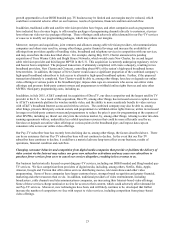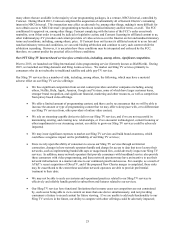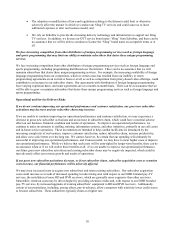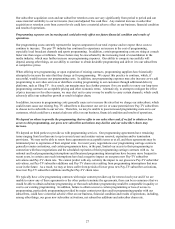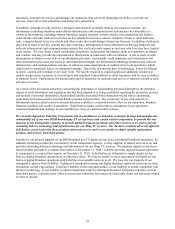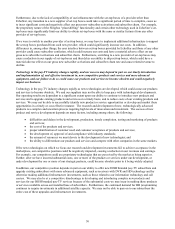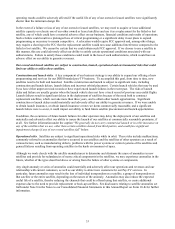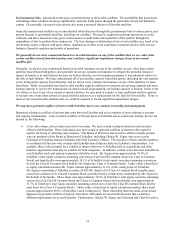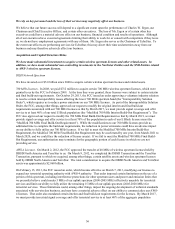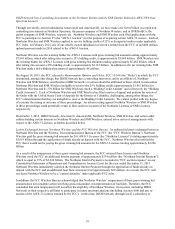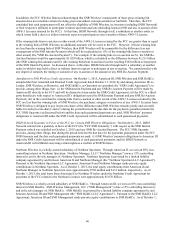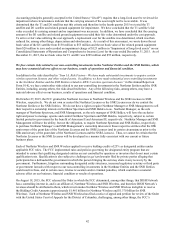Dish Network 2015 Annual Report Download - page 42
Download and view the complete annual report
Please find page 42 of the 2015 Dish Network annual report below. You can navigate through the pages in the report by either clicking on the pages listed below, or by using the keyword search tool below to find specific information within the annual report.32
Our programming signals are subject to theft, and we are vulnerable to other forms of fraud that could require us to
make significant expenditures to remedy.
Increases in theft of our signal or our competitors’ signals could, in addition to reducing gross new subscriber
activations, also cause subscriber churn to increase. To combat signal theft and improve the security of our broadcast
system, we use microchips embedded in credit card sized access cards, called “smart cards,” or security chips in our
receiver systems to control access to authorized programming content (“Security Access Devices”).
Our signal encryption has been compromised in the past and may be compromised in the future even though we continue
to respond with significant investment in security measures, such as Security Access Device replacement programs and
updates in security software, that are intended to make signal theft more difficult. It has been our prior experience that
security measures may only be effective for short periods of time or not at all and that we remain susceptible to
additional signal theft. We expect that future replacements of these Security Access Devices will be necessary to keep
our system secure. We cannot ensure that we will be successful in reducing or controlling theft of our programming
content and we may incur additional costs in the future if our system’s security is compromised.
We are also vulnerable to other forms of fraud. While we are addressing certain fraud through a number of actions,
including terminating independent retailers that we believe violated our business rules, there can be no assurance that we
will not continue to experience fraud which could impact our gross new subscriber activations and subscriber churn.
Economic weakness may create greater incentive for signal theft, piracy and other forms of fraud, which could lead to
higher subscriber churn and reduced revenue.
We depend on independent third parties to solicit orders for our services that represent a significant percentage of our
total gross new subscriber activations.
While we offer products and services through direct sales channels, a significant percentage of our total gross new
subscriber activations are generated through independent third parties such as small satellite retailers, direct marketing
groups, local and regional consumer electronics stores, nationwide retailers, and telecommunications companies. Most
of our independent retailers are not exclusive to us and some of our independent retailers may favor our competitors’
products and services over ours based on the relative financial arrangements associated with marketing our products and
services and those of our competitors. Furthermore, most of these independent retailers are significantly smaller than we
are and may be more susceptible to economic weaknesses that make it more difficult for them to operate profitably.
Because our independent retailers receive most of their incentive value at activation and not over an extended period of
time, our interests may not always be aligned with our independent retailers. It may be difficult to better align our
interests with our independent retailers because of their capital and liquidity constraints. Loss of these relationships
could have an adverse effect on our subscriber base and certain of our other key operating metrics because we may not
be able to develop comparable alternative distribution channels.
We have limited satellite capacity and failures or reduced capacity could adversely affect our DISH branded pay-TV
business.
Operation of our DISH branded pay-TV service requires that we have adequate satellite transmission capacity for the
programming we offer. Moreover, current competitive conditions require that we continue to expand our offering of
new programming. While we generally have had in-orbit satellite capacity sufficient to transmit our existing channels
and some backup capacity to recover the transmission of certain critical programming, our backup capacity is limited.
We lease substantially all of our satellite capacity from third parties, including the vast majority of our transponder
capacity from EchoStar, and we do not carry commercial insurance on any of the satellites that we lease from them.
Our ability to earn revenue from our DISH branded pay-TV service depends on the usefulness of our owned and leased
satellites, each of which has a limited useful life. A number of factors affect the useful lives of the satellites, including,
among other things, the quality of their construction, the durability of their component parts, the ability to continue to
maintain proper orbit and control over the satellite’s functions, the efficiency of the launch vehicle used, and the
remaining on-board fuel following orbit insertion. Generally, the minimum design life of each of our satellites ranges
from 12 to 15 years. We can provide no assurance, however, as to the actual useful lives of any of these satellites. Our



